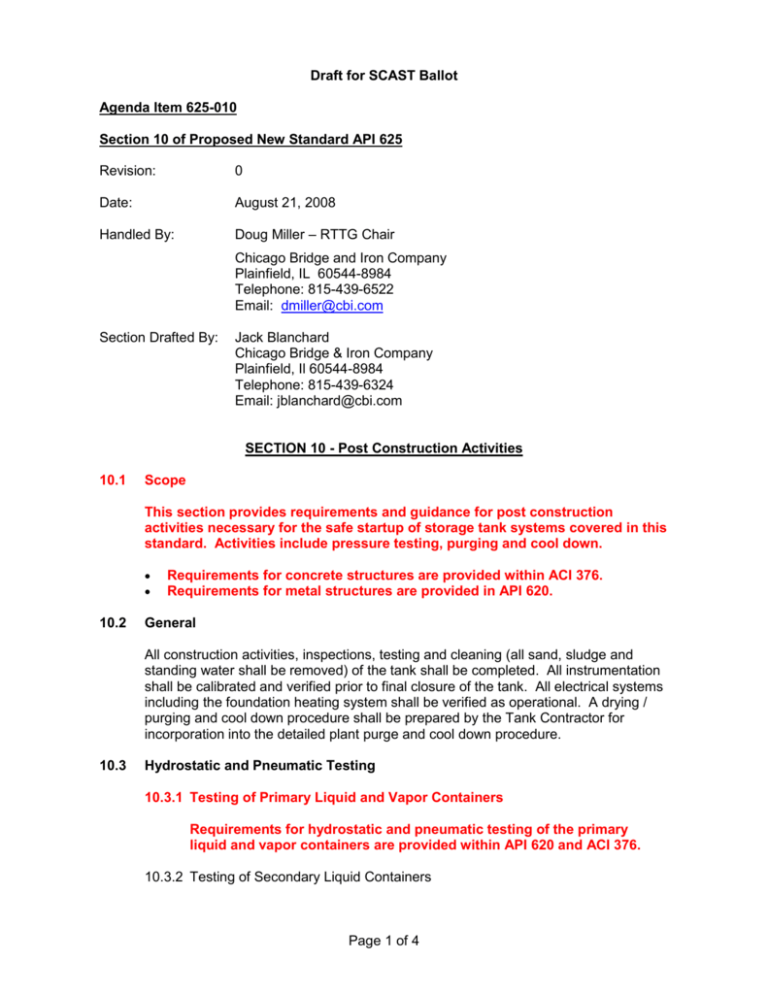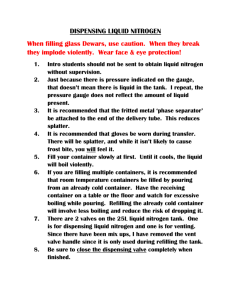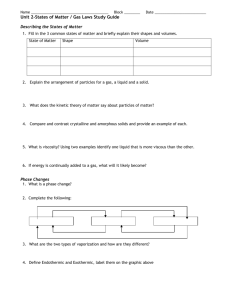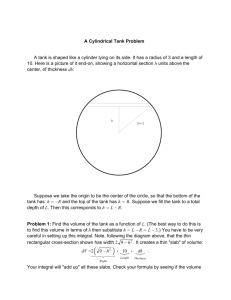625-010PostConstruction
advertisement

Draft for SCAST Ballot Agenda Item 625-010 Section 10 of Proposed New Standard API 625 Revision: 0 Date: August 21, 2008 Handled By: Doug Miller – RTTG Chair Chicago Bridge and Iron Company Plainfield, IL 60544-8984 Telephone: 815-439-6522 Email: dmiller@cbi.com Section Drafted By: Jack Blanchard Chicago Bridge & Iron Company Plainfield, Il 60544-8984 Telephone: 815-439-6324 Email: jblanchard@cbi.com SECTION 10 - Post Construction Activities 10.1 Scope This section provides requirements and guidance for post construction activities necessary for the safe startup of storage tank systems covered in this standard. Activities include pressure testing, purging and cool down. 10.2 Requirements for concrete structures are provided within ACI 376. Requirements for metal structures are provided in API 620. General All construction activities, inspections, testing and cleaning (all sand, sludge and standing water shall be removed) of the tank shall be completed. All instrumentation shall be calibrated and verified prior to final closure of the tank. All electrical systems including the foundation heating system shall be verified as operational. A drying / purging and cool down procedure shall be prepared by the Tank Contractor for incorporation into the detailed plant purge and cool down procedure. 10.3 Hydrostatic and Pneumatic Testing 10.3.1 Testing of Primary Liquid and Vapor Containers Requirements for hydrostatic and pneumatic testing of the primary liquid and vapor containers are provided within API 620 and ACI 376. 10.3.2 Testing of Secondary Liquid Containers Page 1 of 4 Hydrostatic testing of secondary liquid containers of double and full containment tank systems is not required unless explicitly specified by the purchaser. When specified for specific projects, hydrostatic testing of secondary liquid containers shall include the following. Hydrostatic testing of the primary container must be completed prior to the secondary container test and shall not be drained prior to filling and emptying the secondary container. Verification of primary bottom leak tightness must be made during testing of the primary liquid container. The bottom insulation system must be protected from exposure to water during secondary container testing. Water test height for the secondary container shall, as a minimum, be set at a height that produces a liquid pressure in the base of the container equivalent to 1.25 times the pressure produced to contain the full primary container contents at design liquid level. Water quality for the secondary container shall meet the water requirements in API 620. 10.3.2 Pressure Testing of Pump Columns Pump columns shall be pressure tested, hydrostatically or pneumatically, in accordance with the standard used for their design (see paragraph 7.2.3). Pump columns shall be installed prior to hydrostatic testing of the primary liquid container. Pump column internal pressure testing shall be performed with the primary liquid container empty, and the pump column shall be empty when the primary liquid container is hydrostatically tested. 10.3.3 Pressure Testing of Piping Piping shall be pressure tested as required by API 620 Appendix Q or Appendix R. 10.4 Drying / Purging 10.4.1 Immediately following the hydrostatic test of the tank, residual standing water shall be removed. 10.4.2 Excessive free water within the insulation system can cause the insulation system to perform below its design basis and, in the case of cellular glass load bearing insulation could cause damage to the insulation system. Erection procedures shall incorporate provisions that eliminate collection of excessive moisture within the insulation system. 10.4.3 Excessive moisture in the tank atmosphere will be naturally removed from the gas when the gas temperature drops below the dew point of the gas. Therefore, removal of most moisture from the gas within the tank will be achieved through the process of nitrogen and warm gas purges discussed below. The dew point values in Table 10.1 can be used as an indication for when detrimental moisture has been adequately removed. It is not necessary to lower the dew point below 32oF (0oC). If the recommended dew point is Page 2 of 4 reached at the end of the nitrogen purge and if the nitrogen purge is followed by a warm product purge, it is not necessary to take subsequent readings 10.4.4 A nitrogen purge shall reduce the oxygen level in the tank to a level that will allow the product to be introduced without creating a combustible gas mixture. The O2 end point value in Table 10.1 is a value that is considered safe for ethylene per AGA Principles and Practice – 2001. Percent oxygen in nitrogen gas end points for all other gasses covered by this standard could be safely set at a higher level but the dew point values listed will normally be harder to achieve than the 8% O2 level. 10.4.5 A warm product purge to between 80% and 90% product gas normally follows the nitrogen purge and is completed prior to tank cool down. If liquefied gas is introduced directly into a nitrogen environment, the initial introduction can cause the temperature of the liquid to drop below the product design temperature and the design metal temperature. Material selection and tank design must consider this lower temperature if a warm product purge is not performed. 10.4.6 An exception to the O2 values in Table 10.1 is ammonia storage. Anhydrous ammonia storage is susceptible to stress corrosion cracking (SCC). Water additions have been shown to reduce the SCC process and any free moisture exposed to ammonia vapor will combine with the ammonia. The percent O2 at time of liquid accumulation is also important to reduce the SCC process. Therefore, the O2 level achieved prior to cool down (liquid accumulation) is recommended to be lower than the value in Table 10.1 and should be as low as practical. 10.4.7 When the tank is not cooled down immediately following completion of the purging a small positive pressure should be maintained to prevent ingress of oxygen and moisture. When the cool down is delayed more than 2 weeks, the purge dew point end point for the annular space, as measured at the end of the nitrogen purge, should be reduced from the values in table 10.1 by 5oC to stabilize the moisture levels in the tank. 10.4.8 Purge dew point levels recommended for primary concrete containers are found in ACI 376. Table 10.1 Recommended Drying and Nitrogen Purging End Points for Steel Tanks Section Inner tank and Dome space Annular space (internally insulated double wall suspended deck tanks) Bottom Insulation Space Dew Point at 1 atm O2 Concentration Level (Vol %) -5º C (+23º F) Max. 8% Max. +10º C (+50º F) Max. 8% Max. No measurement necessary No measurement necessary Page 3 of 4 Annular Space of a double wall double roof tank 10.5 No measurement necessary No measurement necessary Cool Down 10.5.1 Cool down shall be performed after the tank purge has been completed. A cool down procedure shall be developed to provide a controlled process. During the initial introduction of liquid product, it is important to insure that the storage tank cools as uniformly as possible. Sharp thermal gradients can cause permanent local distortions and potential crack growth. The cool down rate for the primary liquid container shall be controlled to a maximum average of 5oC/h (9oF/h) and shall not exceed 8oC/h (15oF/h) during any one hour. 10.5.2 For thermal gradients and cool down procedures related to concrete tanks, see ACI 376. 10.5.3 The cool down can be considered complete when a minimum of 150 mm (6 inches) of liquid product is maintained in the storage tank. At this point the bottom TEs and TEs in the first 3 meters (10 ft) of the vertical TE array will be reading approximately product storage temperature Page 4 of 4








